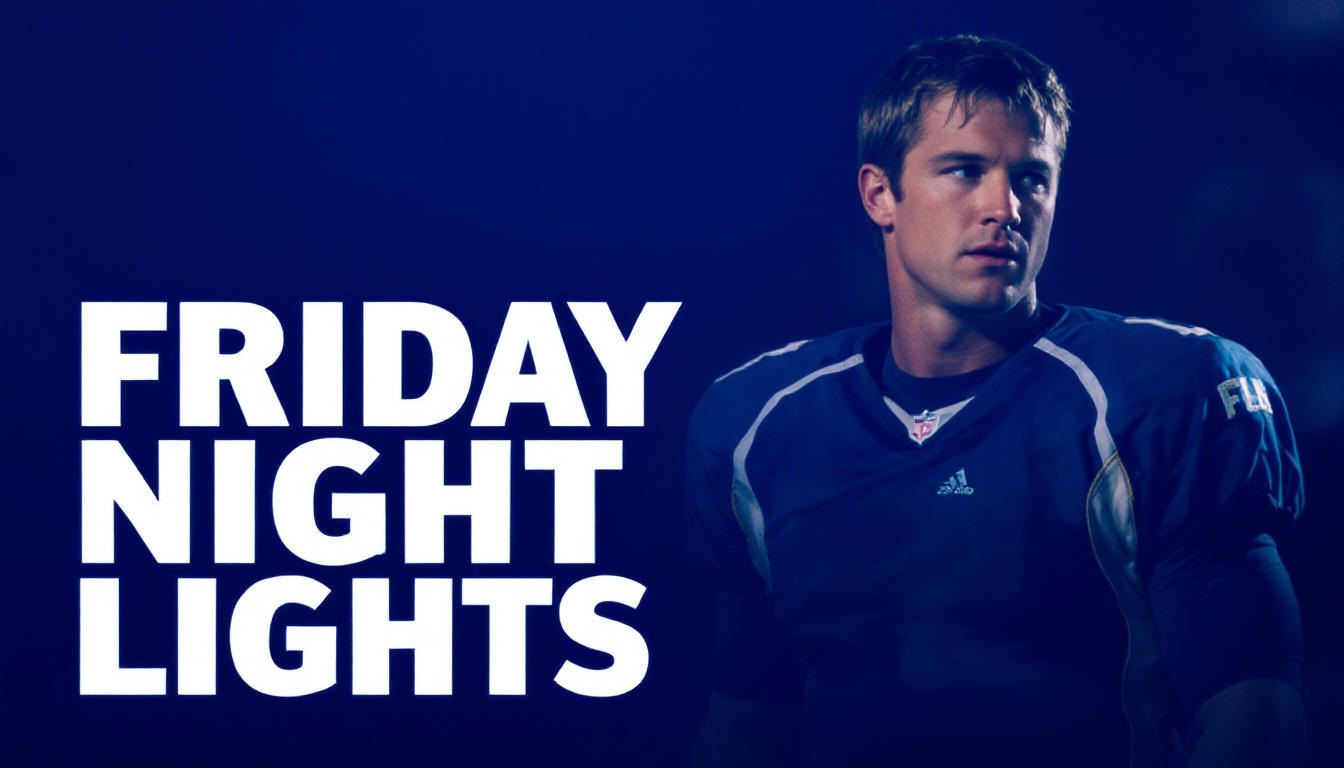Released in 2004, Friday Night Lights is a respected sports drama film directed by Peter Berg. The story adapts H.G. Bissinger’s non-fiction book and transports viewers to Odessa, Texas, a town where high school football is woven into daily life. The film examines the immense pressures and expectations placed on young athletes by their families, coaches, and community.
Friday Night Lights explores the fervor and pride surrounding small-town football. It presents a candid portrait of community obsession, ambition, and the personal costs of chasing athletic glory. Its authentic depiction of Texas football culture has sparked discussion about sports, society, and identity in American communities.
The Story Behind Friday Night Lights
Before Friday Night Lights was a film, it was a book that explored the high-stakes world of Texas high school football. H.G. Bissinger’s reporting brought the 1988 Odessa Permian Panthers and their West Texas community into the national spotlight. The adaptation process and the film’s shooting choices reflect a search for both emotional truth and visual authenticity.
Adapting H.G. Bissinger’s Book
The original book, published in 1990, documented the 1988 football season of Odessa’s Permian High School. Bissinger embedded himself in the town, capturing local pressures, economic challenges, and the racial divides that shaped the young athletes’ lives. The book remains highly regarded as a sports narrative and a study of small-town America.
In adapting the book for the screen, director Peter Berg—Bissinger’s cousin—made significant changes. The film narrows its focus to the team’s playoff run while emphasizing themes of ambition and expectation. Some characters were composited, and events were condensed for clarity. Sensitive topics, like town politics and issues around race, are present but handled differently, balancing narrative drive and respect for the source material.
Artistic liberties were taken to fit the movie format. The film does not capture every subplot from the book but preserves the emotional weight and social context. For viewers interested in how the real players and season unfolded, resources like the Odessa Permian 1988 roster and the UIL Texas 1988 5A Football Conference records provide factual context.
Authentic Texas Atmosphere
 Photo by Tim Mossholder
Photo by Tim Mossholder
Director Peter Berg committed to filming in and around Odessa and Midland to reflect the community’s real setting. Stadiums, streets, and even homes were used to anchor the story in the genuine landscape of West Texas. Local extras and athletes augmented the realism; many scenes rely on students and communities familiar with Permian football traditions.
Efforts to achieve authenticity included rigorous football choreography and the use of actual game footage where possible. On-field action benefited from the participation of former and current Texas high school players. Grass stains, sweat, and nervous anticipation feel tactile, not staged. Filming infused the movie with daily life details—crowded diners, sideline conversations, and school corridors humming with anticipation.
These choices amplify the emotional and visual accuracy, supporting the film’s reputation for being one of the most authentic portrayals of small-town football culture. The result is a film grounded in the lived reality of Odessa during the late 1980s, matching the book’s commitment to detail and genuine storytelling.
Key Themes and Social Commentary
Friday Night Lights (2004) moves beyond football to examine the community’s values and struggles. The film focuses on how high school sports shape identity in Odessa, Texas. It brings up questions about sacrifice, ambition, and belonging in a town bound tightly to its team. These themes reflect broader social and cultural patterns seen across the United States, but are sharply focused by the film’s close look at small-town Texas life.
Pressure and Sacrifice in High School Sports
The film traces the emotional and psychological toll that football exerts on its young athletes. Players face intense expectations from parents, coaches, and peers. Each performance can affect their future and the reputation of their families.
Odessa’s teenagers often become local heroes or scapegoats based on their performance on the field. This pressure does not remain on the field—it invades their homes and daily lives. Some families view football as a way out of financial hardship, pushing dreams of scholarships and fame. Others experience it as a tradition, handed down across generations.
- Parental expectations: Parents project their hopes onto their children, sometimes reliving their own ambitions.
- Coaching intensity: Coaches demand commitment and toughness, at times stretching the limits of what is fair for adolescents.
- Physical and emotional risks: Injuries and setbacks can derail a player’s future and impact their mental health.
By showing the sacrifices required to compete at this level, the film raises questions about priorities in youth sports. Success is fleeting and often comes at a personal cost. The story highlights how dreams and community pride depend on the ability and health of a few teenagers.
Race, Class, and Social Dynamics in Odessa
 Photo by cottonbro studio
Photo by cottonbro studio
While the film focuses on football, it subtly addresses the intersecting issues of race and socioeconomic status in Odessa. The town’s history with segregation, inequality, and uneven opportunity plays a role in the story, whether directly acknowledged or left in the background.
In both the real events and the source material, race and class affected every aspect of life and sports in West Texas. The Permian Panthers’ roster reflected the divided demographics of Odessa. Friendships and team cohesion formed in the locker room, but deep community divisions persisted outside of it. Access to resources, quality of support, and future opportunities could look different depending on where a player came from.
Key social dynamics include:
- Racial divisions: The racial divides of Odessa influence who gets celebrated and who is overlooked, sometimes shaping opportunities on and off the field.
- Economic pressures: Many families rely on sports as an escape from limited job prospects and tough living conditions. Football is treated as a potential path to college or a better way of life.
- Public scrutiny: Players and their families navigate judgments based on reputation, background, and community loyalty.
The film’s handling of these topics is more restrained than the book, which explores the full weight of racial and class tensions. Still, Friday Night Lights serves as a springboard for sociological discussions on identity, unity, and exclusion. By presenting only glimpses of these realities, the movie encourages viewers to consider whose stories are most visible and whose remain in the background of small-town sports culture.
Critical Reception and Legacy
Critical assessments of Friday Night Lights (2004) have focused on its unembellished portrayal of high school football and the strong performances that anchor its narrative. The film’s impact extends beyond initial reviews: it has shaped how audiences and filmmakers approach the sports genre, with its influence visible in both cinematic storytelling and broader cultural conversations about youth athletics.
Review Highlights and Critic Perspectives
 Photo by Sean P. Twomey
Photo by Sean P. Twomey
Upon release, Friday Night Lights received substantial praise for its authenticity. Critics commended the film’s dedication to capturing the atmosphere of Odessa and the lived experience of its characters. Notable review aggregators like Rotten Tomatoes highlighted the film’s consistent strength, recognizing the direction and cinematography for helping to immerse viewers in the world of Texas football. The film holds a strong approval rating among critics, affirming its wide appeal in both sports and drama circles (Rotten Tomatoes: Friday Night Lights).
Key critical perspectives include:
- Authenticity of Setting: Many reviewers acknowledged the realistic depiction of small-town Texas. Local culture, traditions, and hardships feature heavily in both visual details and story arcs.
- Emotional Performances: Actors portraying the young athletes and their mentors received credit for grounding the film. Their understated delivery avoided melodrama and underscored the seriousness of the story.
- Narrative Approach: Some criticism focused on the film’s approach to theme development. While it was praised for not idealizing the story, a portion of critics noted that compressed timelines and selective character arcs led to some social issues, such as racial divisions and class dynamics, being addressed only briefly.
The audience response mirrored critical views, with many noting that the film broke away from common sports movie clichés. It avoided sentimental resolutions and instead presented high school football as both an opportunity and a burden for its young players (IMDb: User reviews for Friday Night Lights).
Friday Night Lights earned several award nominations, including recognition from film critic societies and guilds for its writing, editing, and music. It routinely appears in rankings of top sports films, contributing to its reputation as a standard-bearer within its genre (Wikipedia: Friday Night Lights (film).
Influence on the Sports Film Genre
The influence of Friday Night Lights on the sports genre is profound and long-lasting. The film set a new standard for realism and emotional depth, prompting future productions to embrace more honest portrayals of youth sports and community impact.
Key influences include:
- Storytelling Shift: Subsequent sports films adopted a more grounded approach, favoring character-driven plots and authentic dialogue. The focus moved away from triumphant endings to more nuanced narratives that reflect the pressures and limits facing young athletes (Digital Trends: Best football movie of the 21st century).
- Cultural Shift: The film has changed how audiences perceive high school football, presenting it as a mirror for societal issues such as ambition, expectation, and inequality. Its cultural impact can be seen not just in cinema but in related media, including the acclaimed television adaptation, which expanded on the film’s tone and themes (The Spartan’s analysis of Friday Night Lights and sports drama).
- Direct Comparisons: Friday Night Lights is often compared to other major football films such as Varsity Blues and Remember the Titans. These comparisons highlight its focus on authenticity and restraint, in contrast to the more heroic or celebratory tone of earlier works.
The film’s legacy remains evident in both continued academic discussion and regular inclusion in lists of the greatest sports films. Its approach has encouraged other filmmakers to explore the complexity and reality of youth athletic culture, cementing Friday Night Lights as a reference point in American cinema (Confusing Middle: Legacy and influence on television).
Behind the Scenes Insights
The production of Friday Night Lights (2004) stands out for its commitment to realism and its detailed depiction of high school football. Director Peter Berg guided the team through a process anchored in authenticity, demanding both technical precision and genuine emotion from all involved. This section explores key aspects of how the film was made, focusing on choices in filming, as well as the experiences of the cast and crew.
Filming Techniques and Realism
 Photo by Sippakorn Yamkasikorn
Photo by Sippakorn Yamkasikorn
Peter Berg’s direction relied heavily on handheld cameras, which captured a sense of immediacy and allowed the viewer to experience the intensity of the games up close. Unlike more stylized sports films, the camera movement here is often fast, unpredictable, and intentionally unsteady. This approach mirrors the chaos and pressure on the field, putting the audience right in the heart of the action.
Key techniques included:
- Use of actual high school football players: Scenes used local athletes, not just actors, which enhanced on-field authenticity.
- Integration of real game footage: The crew supplemented staged action with game clips from actual Texas high school football matches. This heightened the film’s atmosphere and provided a documentary-like truth to the gameplay.
- Naturalistic lighting and color grading: Cinematography choices favored muted tones and natural lighting, reflecting the real environment rather than glossy Hollywood stylization.
- Minimal rehearsals: Berg often avoided traditional rehearsals. Instead, he encouraged the cast to react in real time—intensifying the sense of unpredictability and tension.
These methods resulted in a visual style that sets Friday Night Lights apart from many sports dramas. The audience often feels as though they are watching an event unfold in real time, with little separating them from the players’ triumphs and failures. By centering realism, the film’s tension and atmosphere resonate with both sports fans and general viewers.
Cast, Crew, and Memorable Moments
The cast of Friday Night Lights features strong performances, each shaped by the demanding set environment. Notably, Billy Bob Thornton’s restrained portrayal of Coach Gary Gaines anchors the film with quiet authority. Actors portraying the high school athletes—including Derek Luke (Boobie Miles), Garrett Hedlund (Don Billingsley), and Lucas Black (Mike Winchell)—were cast for their ability to inhabit complex roles rather than simply mimic football players.
Several behind-the-scenes details highlight the film’s production challenges:
- Physical preparation: Actors underwent rigorous football training, often practicing with actual teams in Odessa. Injuries nonetheless occurred, further blurring the line between film set and real sport.
- Emotional demands: Scenes involving community disappointment, loss, and family expectation placed significant stress on the cast. Director Peter Berg was known for long takes, requiring actors to maintain high emotion through extended shooting periods.
- Local involvement: The filmmakers included residents of Odessa in many scenes, both as extras and advisors. Their insights contributed to the sense of place and helped the actors understand the stakes involved for real families.
Interviews with Peter Berg highlight several notable anecdotes. One example is the decision to avoid choreographed “hero shots” in favor of letting plays unfold naturally, even if mistakes happened. This resulted in unplanned moments becoming part of the film’s most memorable scenes, providing an unscripted sense of drama. The performances drew praise for their restraint and intensity, helping make the story more relatable and grounded.
The entire production process, from rigorous athletic training to the integration of locals, underscores the dedication to making a film that feels true. The director’s decisions and the cast’s efforts give Friday Night Lights its lasting authenticity and impact.
The Enduring Impact: Beyond the Movie
After its 2004 debut, Friday Night Lights proved its reach extended far beyond the screen. The film’s effect rippled into other media and shaped public understanding of sports and community for years.
Friday Night Lights TV Series and Cultural Legacy
The Friday Night Lights television series, which began in 2006, expanded and enriched the film’s core themes. While the show was inspired by the movie—and by extension, H.G. Bissinger’s book—it developed its own identity and greater depth over five seasons. The series adapted the character-driven storytelling of the film while exploring more complexities within the fictional town of Dillon, Texas.
The show focused on the challenges faced by players, coaches, families, and the broader community. It offered time to delve into topics only touched on in the film, such as local politics, changing social dynamics, and the personal cost of long-term commitment to a sport. The writing and performances earned critical acclaim, especially for presenting the realities of race, class, and belonging in an honest light.
The cultural conversation around sports in America shifted as a result. The series’ influence can be seen in how later shows and movies address high school athletics. It established new standards for realism and emotional weight and is often cited as a benchmark for sports drama storytelling across television and film. The term “Friday Night Lights” itself became shorthand for small-town football culture, symbolizing both hope and hardship.
Continuing Relevance in American Sports Culture
Friday Night Lights continues to be relevant in American sports culture due to its honest portrayal of ambition, inequality, and community bonds. High school football remains a central institution in many American towns. The film and its adaptations highlighted how these games create powerful shared experiences, shaping local identity and aspirations.
The story’s focus on the pressures faced by young athletes still speaks to audiences. Parents, coaches, and players recognize the cycle of expectations, dreams, and limitations. The issues seen in the movie—inclusive of socioeconomic gaps, access to opportunity, and the costs required for success—remain prevalent in today’s sports environment. The film prompts reflection on the value placed on athletic achievement versus personal growth or academic goals.
Key factors that sustain the film’s relevance include:
- Ongoing debates about the health and safety of young athletes.
- Increased awareness of the social functions and divisions reinforced by high school sports.
- The persistent draw of “Friday night” as a community event symbolizing unity, rivalry, and pride.
The legacy of Friday Night Lights is visible not just in continued pop culture references, but also in academic studies and ongoing discussions about the realities of high school football. Its central ideas are discussed in classrooms, on editorial pages, and among families nationwide. The movie and its adaptations provide a lens through which to view the intersection of aspiration, struggle, and the powerful connection between sports and community.
Conclusion
Friday Night Lights (2004) endures as a definitive sports film, noted for its honest portrayal of community pressure and the lived realities of high school athletes. The film’s attention to social dynamics, authenticity in storytelling, and refusal to offer easy resolutions have helped set a standard in its genre. Its depiction of ambition, sacrifice, and local identity remains relevant as American towns continue to rally around Friday night games.
For a deeper perspective on the line between fact and fiction in the story, explore Friday Night Lights: Movie Review, True Story vs. Fiction.
Friday Night Lights remains a touchstone for anyone examining American sports and cultural narratives. Thank you for reading, and consider how these themes shape your own view of community and competition.









